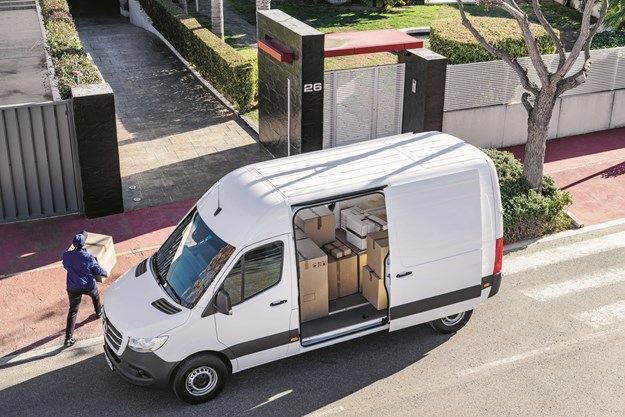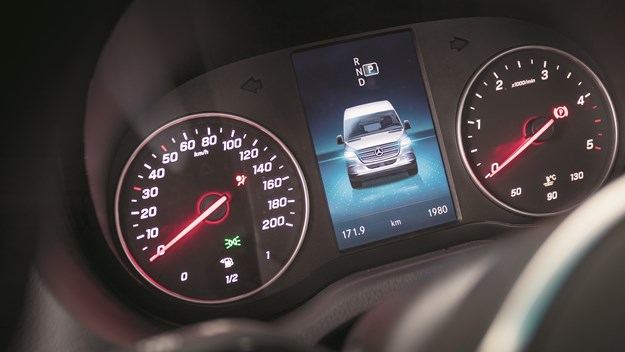25 years of innovation: the Mercedes-Benz Sprinter celebrates its silver anniversary
Twenty-five years ago, a van that would go on to lend its name to an entire vehicle segment was launched on the market: the Mercedes-Benz Sprinter.
Today, a quarter of a century later, the current generation still represents the benchmark for the competition.
Alongside its timeless values such as quality, reliability, economy and comfort, the current Sprinter also stands for networking and connectivity and – with the recent launch of the eSprinter variant – for emission-free transportation too.
VAN EXPERTISE SINCE 1955
Even the first Sprinter generation was nothing less but the result of 40 years of van expertise at Mercedes-Benz, as the L319 celebrated its debut in 1955.
As the first transporter with the star on its radiator grille, it had a gross vehicle weight of 3.6 tons, which was mobilised by the 43hp (32kW) diesel engine of the 180D passenger car.
In 1967, the T2 series, known as the ‘Düsseldorf Transporter’ and manufactured for almost 30 years, revolutionised the van market. Power steering, later on even an automatic transmission, and up to 130hp (97kW) diesel engines, as well as noticeably better soundproofing, brought comfort and ergonomics into focus.
The ‘Bremen Transporter’, or T1, introduced in 1977, is considered the direct predecessor of the Sprinter. For the first time, the series was equipped with front disc brakes. Later, anti-lock brakes (ABS) and air-conditioning represented further innovations in the commercial vehicle segment.
.jpg) |
|
The first Sprinter generation was the result of 40 years of van expertise at Mercedes-Benz, stretching back to the L319, which made its debut in 1955
|
1995: A VAN ANTICIPATES THE COMING DECADE
In 1995 the Sprinter defined an entire size segment and played a part in aiding the transition to e-commerce: when the current dimensions of online trade were barely imaginable, the Stuttgart brand presented an ultramodern van that was ideal for the logistics challenges ahead.
With disk brakes at the front and rear wheels, ABS including the automatic brake differential (ABD), a more aerodynamic body, low fuel consumption and many other innovations, the Sprinter set standards with regard to safety, efficiency and comfort and became the worthy successor to the legendary T1. According to various media sources, this made it the eponym for the ‘Sprinter class’.
From the outset, the new van was positioned as truly multi-talented: it was available as a chassis, platform vehicle or tipper vehicle, with a crew cab or a single cab respectively, as a panel van and as a crew bus with five or nine seats, with a low or high roof.
The wheelbases ranged from 3,000 to 4,025mm; while the permissible gross mass was initially 2,590, 2,800 or 3,500kg – both optimum prerequisites for numerous fields of application such as construction sites and other trades, passenger transportation, and fire and rescue services.
In the past 25 years the van has also cut a fine figure as a camper van and as the basis for many different special bodies.
 |
|
The Sprinter – 25 years of transportation: from left to right: Benjamin Kaehler, head of eDrive@VANs; and Norbert Kunz, head of marketing, Mercedes-Benz Sprinter
|
2006: TAILOR-MADE SOLUTIONS
More than 1.3 million Sprinter sales and several facelifts later, in 2006 Mercedes-Benz presented a comprehensive further development: whilst there had previously already been a very broad range of variants, customers were now able to access a tailor-made solution for practically any requirement. The bodybuilders’ portal, which provides all the information required for realising customer requests, also played a key role.
The new vehicle was characterised by numerous innovations: for example, an extra-wide load compartment sliding door, the super-high roof and a fourth body length.
Powertrains were further optimised with a new range of engines and a new six-speed transmission for diesel variants.
There was also an improved brake system, ‘Adaptive ESP’, with extended functions for all tonnages and a revised stowage concept in the vehicle interior.
Other new features included the wide-base tyres at the rear axle for the 4.6-tonne variant, the bi-xenon headlamps with static cornering and curve lights, a thorax bag for the driver and co-driver, the ‘Parktronic’ system and much more.
-extended.jpg) |
|
The Sprinter’s broad range of variants remains impressive: more than 1,000 different versions of the current Sprinter can be configured from the possible bodies, chassis, drive concepts, tonnages and equipment details alone
|
2013: MORE OUTPUT, MORE SAFETY
With an efficient drivetrain and numerous innovations, the further-developed Sprinter from 2013 again took up a new top position among the competition.
Contributing factors were, among other things, an efficiency package with ‘ECO’ steering assistance pump, the ‘ECO’ start/stop function and a long rear-axle ratio.
Thanks to the latest engine technology featuring SCR technology, the Sprinter was the first van to meet the Euro 6 exhaust emissions standard.
In addition to an extended mobility guarantee and the seven-speed automatic transmission (7G-Tronic Plus), customers had yet more equipment options to choose from.
The focus was again on safety in particular: the Sprinter was now the first van to be equipped as standard with ‘Crosswind Assist’ for closed vehicle models.
Adaptive high-beam assist, lane-keeping assist, blind spot assist and collision prevention assist are just some of the features also available.
 |
|
The new-generation Sprinter launched in 2006 was characterised by numerous innovations: for example, an extra-wide load compartment sliding door, the super-high roof and a fourth body length
|
2018: INTELLIGENT CONNECTIVITY
The third-generation Sprinter was the first model series to embody the Mercedes-Benz Vans ‘adVANce’ philosophy in 2016 as a provider of comprehensive mobility solutions. It combines progressive design with comfort and safety features only usually seen in passenger cars.
The extensive networking with the internet is revolutionary: the Mercedes ‘PRO’ connect services and the multimedia system MBUX (Mercedes-Benz User Experience) are setting the points in the direction of the future and creating new possibilities for managing a large fleet and for small businesses alike. The service enables orders to be managed online and vehicle information such as the location, fuel supply or maintenance intervals to be called up practically in real time. There are eight Mercedes PRO connect packages, with central services available ex-factory.
The Sprinter’s broad range of variants remains impressive: more than 1,000 different versions of the current Sprinter can be configured from the possible bodies, chassis, drive concepts, tonnages and equipment details alone.
As of 2018 there was also more choice with regard to the engine thanks to the front-wheel drive available for the first time and two transmissions developed for it, as well as a nine-speed automatic transmission with converter.
 |
|
The third-generation Sprinter was the first model series to embody the Mercedes-Benz Vans ‘adVANce’ philosophy in 2016 as a provider of comprehensive mobility solutions
|
2019: THE ELECTRIC ERA
Economical, reliable and flexible as before, but now also able to distribute goods, drive to construction sites or respond to servicing call-outs, all with zero local emissions – the eSprinter presented at the end of 2019 is made for these applications.
Its electric front-wheel drive has an output of up to 85kW with a torque of up to 295 newton metres.
An adjustable payload and battery concept takes account of individual requirements: with a usable battery capacity of 47kWh, its range is 168km, with a maximum payload of 891kg.
Anyone valuing more payload can simply opt for a lower battery capacity of 35kWh (installed: 41kWh), which enables a range of 120km. In return, the maximum payload increases to 1,045km.
Flexibility is also provided with the integrated fast-charging function which allows the battery to be charged from 10 per cent to 80 per cent within approximately 25 minutes.
The top speed can also be configured to suit the purpose: to a maximum speed of 80km/h, 100km/h or 120km/h.
-(1).jpg) |
|
Economical, reliable and flexible as before, but now also able to distribute goods, drive to construction sites or respond to servicing call-outs, all with zero local emissions – the eSprinter presented at the end of 2019 is made for these applications
|

